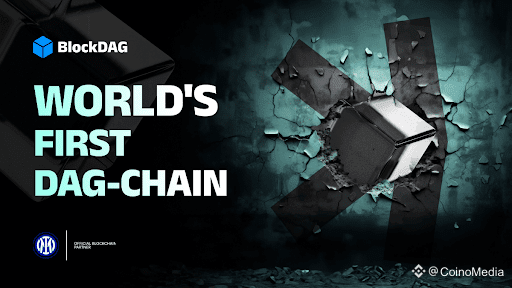
As blockchain technology evolves to meet rising demands for scalability, decentralization, and interoperability, a new contender has entered the field: BlockDAG. Although still in its presale stage, BlockDAG (BDAG) has already raised more than $342 million and sold over 24 billion BDAG coins, drawing attention from developers, miners, and crypto enthusiasts alike. But what exactly is BlockDAG, and how does it set itself apart from traditional blockchain platforms?
This article takes an exploratory look at the architecture, technical vision, and why many are considering BlockDAG a serious Layer 1 alternative heading into 2025.
The Hybrid Design: Merging DAG and Blockchain for Speed and Security
At its foundation, BlockDAG is a Layer 1 platform that combines Directed Acyclic Graph (DAG) architecture with elements of conventional blockchain consensus. DAG is a graph-based structure that enables asynchronous transaction processing. Unlike blockchains, which group transactions into fixed blocks, DAG systems allow multiple transactions to be verified simultaneously.
This approach enables BlockDAG to achieve throughput between 2,000 and 15,000 transactions per second (TPS), far surpassing Bitcoin’s approximate 7 TPS or Ethereum’s 30 TPS without rollups.
What makes BlockDAG stand out is its integration of proof-of-work (PoW), the same consensus method used by Bitcoin, rather than adopting proof-of-stake (PoS) like many recent platforms. This choice preserves decentralization and provides Sybil resistance, while benefiting from the parallel processing power of DAG.
The resulting hybrid system aims to balance three often-competing goals: speed, security, and decentralization, a challenge that has long faced Layer 1 projects.
EVM Compatibility and the Push Toward Low-Code Development
One of BlockDAG’s strategic advantages is its full compatibility with the Ethereum Virtual Machine (EVM). This allows developers to migrate Solidity-based smart contracts to BlockDAG without rewriting code, enabling Ethereum tools, wallets, and decentralized applications (dApps) to function natively.
In addition, the team has introduced a low-code smart contract builder that empowers users with minimal coding experience to create and deploy smart contracts using a simple visual interface. This feature is designed to lower entry barriers for startups, businesses, and creators exploring blockchain for the first time.
By combining EVM support with low-code tools, BlockDAG positions itself as both developer-friendly and accessible to non-technical participants. Its ecosystem conceptually resembles Avalanche or BNB Chain but promises added throughput and decentralization thanks to its hybrid architecture.
Building the Ecosystem: Testnet, Grants, and Mining at Scale
BlockDAG has already launched its testnet, giving developers the ability to test contracts, interact with the chain, and assess performance metrics. To further accelerate growth, the team has rolled out grant programs and hosted hackathons, aiming to support more than 1,000 dApps by 2026.
Mining infrastructure is another area of focus. Over 2 million users have downloaded the X1 mobile miner app, which helps users simulate mining rewards and learn about the network. Meanwhile, over 18,500 ASIC mining units have been sold, preparing a decentralized hashrate base even before the mainnet launch.
Whereas some Layer 1 networks struggle to attract builders and users after launch, BlockDAG seems intent on fostering early adoption and activity well in advance.
A Transparent Launch Roadmap: What Comes Next
BlockDAG has outlined a six-week phased launch plan, providing an uncommon level of transparency among early-stage projects. The timeline includes:
Week 6: Presale closes; wallet migration and staking end
Week 4: Mainnet activation with infrastructure and mining nodes
Week 3: Community nodes and mining pools go live
Week 2: 40 percent of presale coins distributed via airdrop
Week 1: DeFi ecosystem, including DEX, bridge, and lending, deployed before exchange listing
This structured rollout offers a clear view of how the network intends to transition from presale to a fully operational Layer 1.
Assessing the Market: Funding, Valuation, and Future Potential
Currently priced at $0.0016 per BDAG during the presale, the coin is set to list at $0.05 when trading begins. The project’s ultimate presale goal is $600 million, of which $342 million has already been secured.
To put that in perspective, Avalanche and Aptos raised around $350M and $200M respectively before launch, placing BlockDAG among the most heavily funded early-stage Layer 1 projects to date. Such funding generally supports liquidity, grants, and infrastructure scaling beyond just launch activities.
Some analysts have speculated that, if current momentum holds and ecosystem participation grows post-launch, BlockDAG could reach a top 50 market cap position. However, these projections remain speculative and depend heavily on sustained adoption.
Is BlockDAG Worth Following?
As with all early-stage blockchain projects, BlockDAG involves risk. Yet, what distinguishes it is the depth of its infrastructure and preparedness. With a live testnet, EVM support, builder tools, strong presale funding, and a transparent rollout plan, BlockDAG is positioning itself as more than just another presale coin.
Its hybrid DAG plus PoW architecture offers an intriguing combination of performance, decentralization, and security, addressing limitations seen in earlier Layer 1 designs. Add to that a developer-friendly ecosystem and a growing mining community, and BlockDAG emerges as one of the more notable Layer 1 efforts to watch in this cycle.
Whether its post-launch adoption can match its current presale success remains to be seen. But for those exploring the next phase of blockchain evolution, BlockDAG is becoming increasingly difficult to overlook.
Presale: https://purchase.blockdag.network
Website: https://blockdag.network
Telegram: https://t.me/blockDAGnetworkOfficial
Discord: https://discord.gg/Q7BxghMVyu
The post Analysing BlockDAG (BDAG): A Deep Dive Into the Architecture of a Promising Layer 1 appeared first on CoinoMedia.



